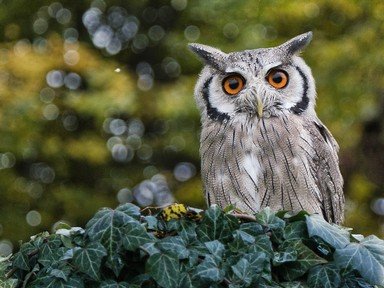Quiz Answer Key and Fun Facts
1. We often see owls portrayed in popular culture wearing glasses. Is this because they are naturally short-sighted?
2. Some owl species have one ear that is higher than the other. Why is this?
3. Owls have five types of feathers, but one specialised feather adaptation allows an owl to have a noise advantage over its prey. Where are these uniquely adapted structures in an owl?
4. An owl has uniquely shaped talons to optimise prey capture. When not hunting the owl has three forward facing toes and one rear-facing. When hunting, one of its forward facing toes can swivel to rear facing to better ensure captured prey is secured.
5. As a bird of prey, owls will hunt for insects, mice, other rodents and larger species may even hunt small foxes and rabbits. The owl's digestive system is unique even amongst birds. Which one of the following is *NOT* a feature of an owl's digestive system?
6. Owl reproduction is similar to other bird species. Which one of the following habits is *NOT* true?
7. What types of nest do owls make?
8. Owls have a poor sense of smell.
9. Given an owl cannot move its eyes from side to side, how does an owl see anything that is not straight ahead?
10. So now we return to where we started: An owl with glasses. Owls are portrayed as sage and wise but are not. Which of the following options is *NOT* a reason why this myth is perpetrated?
Source: Author
1nn1
This quiz was reviewed by FunTrivia editor
rossian before going online.
Any errors found in FunTrivia content are routinely corrected through our feedback system.
